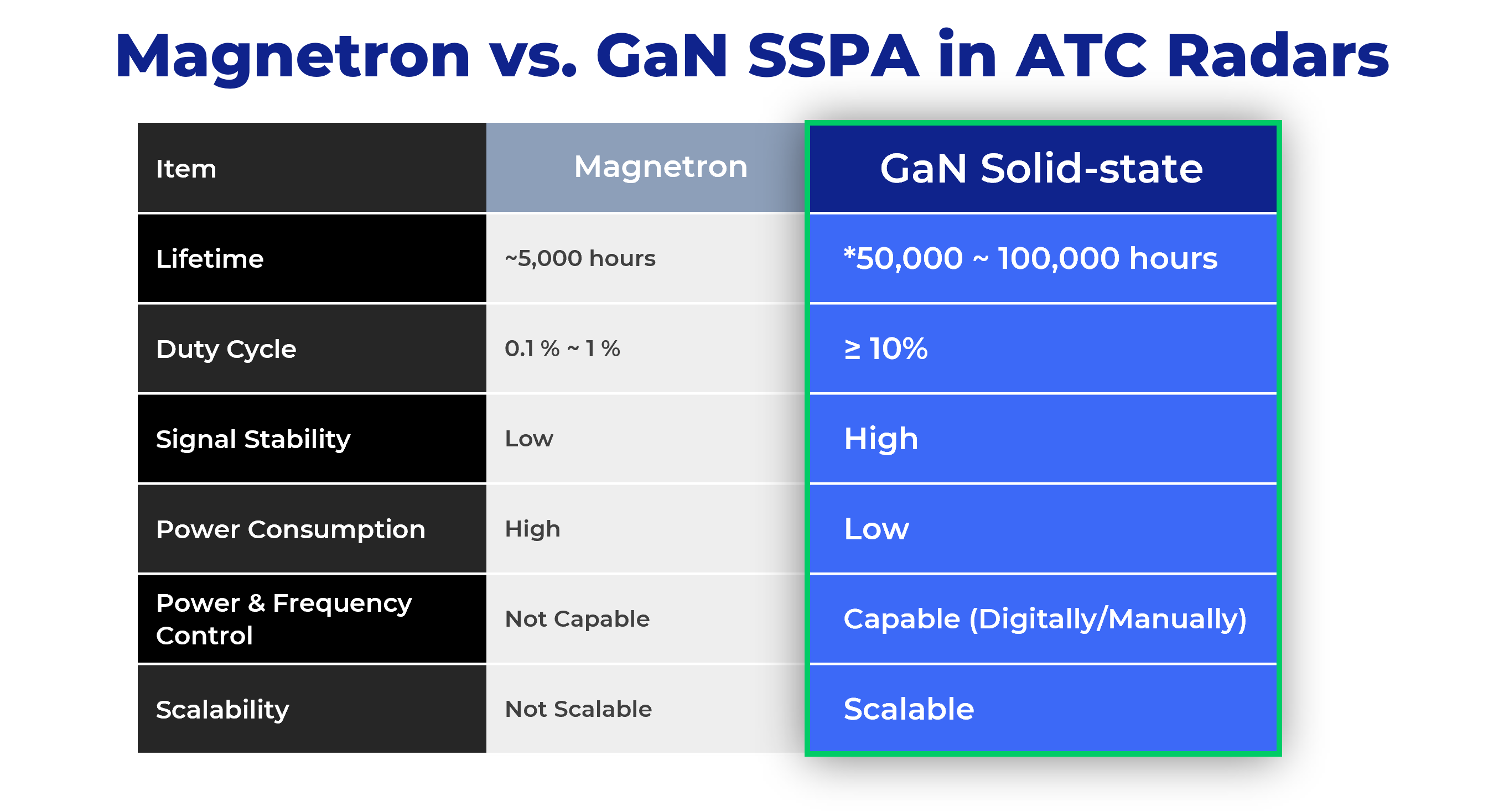Wireless Infrastructure


Air Traffic Control (ATC) radars are critical for ensuring the safe and efficient movement of aircraft. Traditionally, these systems relied on magnetron-based transmitters, which, while affordable, face limitations in reliability and scalability. However, the rise of AI technologies and the need for real-time data processing have driven the shift towards digital-based SSPA (Solid-State Power Amplifier) solutions.
Modern ATC systems require predictive analytics, automated decision-making, and seamless integration with airspace management platforms—capabilities better supported by GaN (Gallium Nitride) solid-state technology. These digital systems offer greater reliability, higher power density, and lower maintenance costs, meeting the growing demands for flexibility and future upgrades. As AI and software-driven innovations continue to shape ATC operations, the transition to solid-state radar ensures scalability and long-term efficiency.
Overview of ATC Radar Systems
ATC radar systems are divided into two primary types:
Both Primary Surveillance Radar (PSR) and Secondary Surveillance Radar (SSR) systems have traditionally relied on magnetron transmitters due to their ability to produce high-power pulses necessary for long-range detection. However, GaN solid-state technology is increasingly being adopted for its superior performance and operational benefits.
Advantages of GaN Solid-State Technology in ATC Radars

1. Enhanced Reliability and Lower Maintenance
Magnetron transmitters, while powerful, have a limited operational lifespan (typically 2,000 to 5,000 hours) due to the wear and tear on their vacuum tubes. This necessitates frequent replacements and maintenance, leading to increased operational costs and potential downtime. In contrast, GaN solid-state transmitters offer significantly longer lifespans, often reaching 50,000 hours to 100,000 hours. This increased reliability reduces maintenance requirements and ensures higher system availability, which is critical for continuous air traffic management.
2. Improved Signal Stability and Accuracy
Magnetron-based systems are prone to frequency drift and phase noise, which can affect the stability and accuracy of the radar signal. This can result in less precise aircraft tracking, especially at long ranges or in challenging weather conditions. GaN solid-state technology, on the other hand, provides much more stable and accurate signals, ensuring that ATC systems can track aircraft with greater precision. This is particularly important in environments where accurate positional information is crucial for maintaining safe separation between aircraft.
3. Higher Duty Cycle and Better Performance in All Weather Conditions
The duty cycle of a radar system refers to the proportion of time it actively transmits signals. Magnetron-based radars typically operate with a low duty cycle (around 1%), limiting their ability to sustain continuous operation in challenging conditions. GaN solid-state systems can achieve much higher duty cycles (often exceeding 10%), providing several key benefits for ATC applications.
A higher duty cycle allows for more frequent or longer signal transmissions, resulting in greater radar sensitivity and enhanced detection of smaller or more distant targets. It also boosts average power output, improving signal penetration through heavy rain or clouds. Additionally, more frequent pulse repetition ensures precise tracking of fast-moving aircraft and reliable coverage, even in adverse weather, maintaining safety across controlled airspace.
4. Scalability and Modularity
GaN solid-state technology allows for modular radar designs, where individual transmitter modules can be added, replaced, or upgraded independently. This scalability enables ATC radar systems to be easily expanded or adapted to meet changing air traffic demands without requiring significant overhauls. In contrast, magnetron systems often require complete transmitter replacements when upgrades or repairs are needed, which can be costly and time-consuming.
5. Lower Power Consumption and Improved Efficiency
GaN solid-state transmitters are more efficient than magnetrons, converting more of the input power into usable radio frequency energy. This not only reduces the power consumption of the radar system but also lowers the heat generated, minimizing cooling requirements. As a result, GaN-based ATC radars can operate with smaller power supplies and cooling systems, leading to reduced operational costs and a smaller environmental footprint.
RFHIC’s GaN solid-state solutions for next-generation ATC radars
RFHIC offers a broad range of GaN solid-state power amplifiers and transmitters for air traffic control radars, operating in L-band, S-band and X-band.
Built with RFHIC’s advanced GaN-on-SiC technology and supported by dedicated in-house manufacturing, these products provide the perfect solution for efficient, reliable, and compact air surveillance radars.
L-Band
|
Part Number |
Type | Min Freq. [MHz] | Max Freq. [MHz] | Output Power [W] | Gain [dB] | Duty Cycle [%] |
Pulse Width [us] |
| RRK102010K-550 | Transmitter | 1,000 | 2,000 | 10,000 | 55 | 15 | 100 |
| RRP1214550-14 | Power Amplifier | 1,200 | 1,400 | 550 | 14 | 15 | 500 |
| RRP131K0-10 | Power Amplifier | 1,200 | 1,400 | 1,200 | 54 | 20 | 500 |
S-Band
|
Part Number |
Type | Min Freq. [MHz] | Max Freq. [MHz] | Output Power [W] | Gain [dB] | Duty Cycle [%] |
Pulse Width [us] |
| RRP27312K5-30 | Power Amplifier | 2,700 | 3,100 | 2,800 | 30 | 10 | 100 |
| RRT273115K-690 | Transmitter | 2,700 | 3,100 | 15,000 | 72 | 10 | 100 |
| RRP27371K5-30 | Power Amplifier | 2,700 | 3,700 | 1,500 | 30.7 | 10 | 200 |
C-Band
|
Part Number |
Type | Min Freq. [MHz] | Max Freq. [MHz] | Output Power [W] | Gain [dB] | Duty Cycle [%] |
Pulse Width [us] |
| RFMR57-CTRM-020SP-500A-SM | Transmit & Receive Module | 5,400 | 5,900 | 20 | 40 | 10 | 50 |
| RRP54591K2-42 | Power Amplifier | 5,400 | 5,900 | 1,200 | 42 | 10 | 100 |
| RRK56578K5-790 | Transmitter | 5,600 | 5,700 | 8,500 | 79 | 10 | 100 |
X-Band
|
Part Number |
Type | Min Freq. [MHz] | Max Freq. [MHz] | Output Power [W] | Gain [dB] | Duty Cycle [%] |
Pulse Width [us] |
| RRT901005K0-570 | Transmiter | 9,000 | 10,000 | 5,000 | 57 | 10 | 100 |
| RRT9397400-560 | Power Amplifier | 9,300 | 9,700 | 400 | 54 | 10 | 100 |
| RRP9596500-55 | Power Amplifier | 9,500 | 9,600 | 500 | 55 | 10 | 100 |
|
To learn more about RFHIC’s GaN Solid-State Solution for naval radars, please fill out the form below. |